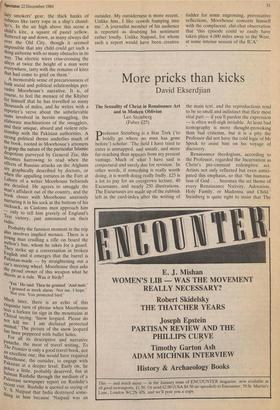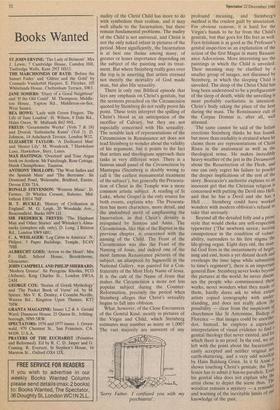More pricks than kicks
David Ekserdjian
The Sexuality of Christ in Renaissance Art and in Modern Oblivion Leo Steinberg (Faber £25)
professor Steinberg is a Star Trek ('toboldly go where no man has gone
before') scholar: 'The field I have tried to enter is unmapped, and unsafe, and more far-reaching than appears from my present vantage. Much of what I have said is conjectural and surely due for revision.' In other words, if something is really worth doing, it is worth doing really badly. £25 is a lot to pay for an overgrown lecture, 40 Excursuses, and nearly 250 illustrations. The Excursuses are made up of the rubbish left in the card-index after the writing of the main text, and the reproductions tend to be so small and indistinct that their most vital part — if you'll pardon the expression — is often well-nigh invisible. At least bad iconography is more thought-provoking than bad criticism, but it is a pity the Professor did not have the cold logic of Mr Spock to assist him on his voyage of discovery.
Renaissance theologians, according to the Professor, regarded the Incarnation as Christ's pre-eminent redemptive act. Artists not only reflected but even antici- pated this emphasis, so that 'the theme of God . . . becomes the set theme of every Renaissance Nativity, Adoration, Holy Family, or Madonna and Child.' Steinberg is quite right to insist that The nudity of the Christ Child has more to do with symbolism than realism, and it may well allude to the Incarnation, but there remain fundamental problems. The nudity of the Child is not universal, and Christ is not the only naked infant in pictures of the period. More significantly, the Incarnation is at best one theme among many, of greater or lesser importance depending on the subject of the painting and its treat- ment. But where Steinberg really.goes over the top is in asserting that artists stressed not merely the mortality of God made man, but also His sexuality.
There is only one Biblical episode that lays any emphasis on Christ's genitals, but the sermons preached on the CircumcisiOn quoted by Steinberg do not really prove his point. These texts interpret the spilling of Christ's blood as an anticipation of the sacrifice of Calvary, but they are . not especially concerned with His sexuality. The notable lack of representations of the Circumcision in Renaissance art does not lead Steinberg to wonder about the validity of his argument, but it points to the fact that artists and theologians approach their tasks in very different ways. There is a famous small panel of the Circumcision by Mantegna (Steinberg is doubly wrong to call it 'the earliest monumental treatment of the subject'), but generally the Presenta- tion of Christ in the Temple was a more common artistic subject. A reading of St Luke, whose Gospel is the only source for both events, explains why. The Presenta- tion has more characters, more detail, and the undoubted merit of emphasising the Incarnation, in that Christ's divinity is recognised by Simeon and Anna. The Circumcision, like that of the Baptist in the previous chapter, is concerned with the naming of the Child. The Feast of the Circumcision was also the Feast of the Naming of Jesus, and indeed one of the most famous Renaissance pictures of the subject, an altarpiece by Signorelli in the National Gallery, was painted for a Con- fraternity of the Most Holy Name of Jesus. It is the cult of the Name of Jesus that makes the Circumcision a more not less popular subject during the Counter- Reformation, precisely the period When Steinberg alleges that Christ's sexuality begins to fall into oblivion.
What, however, of the Close Encounters of the Genital Kind, mostly in pictures of the Virgin and Child, which Steinberg estimates may number as many as 1,000? The vast majority are innocent of any
'Sorry Father. I confused you with my psychiatrist'.
profound meaning, and Steinberg's method is the crudest guilt by association. For obvious reasons, it is hard for the Virgin's hands to be far from the Child's genitals, but that goes for His feet as well. Foot-fetishism is as good as the Professor's genital inspection as an explanation of the action of the first Magus in many Renaiss- ance Adorations. More interesting are the paintings in which the Child is unveiled. Their meaning. may be clarified by a smaller group of images, not discussed by Steinberg, in which the sleeping Child is unveiled. The sleep of the Christ Child has long been understood to be a prefiguration of the sleep of death, while the unveiling is most probably eucharistic in intention, Christ's body taking the place of the host during the mass. The Renaissance cult of the Corpus Domini is, after all, well attested.
The same cannot be said of the Infant erections Steinberg thinks he has found, but more than credulity is strained when he claims there are representations of Christ Risen in the anatomical as well as the theological sense. He makes incredibly heavy weather of the jest in the Decameron about the Resurrection of the Flesh, and one can only regret his failure to ponder the deeper implications of the rest of the story. Boccaccio's anchorite explains to an innocent girl that the Christian religion is concerned with putting the Devil into Hell, and that he has a Devil and she has a Hell . . . Steinberg could have worked wonders with modern oblivion's refusal to take that seriously. Beyond all the detailed folly and a prose style that would choke any self-respecting typewriter (`The newborn savior, nesting omnipotence in the condition of vulner- ability, surrenders to his first stigma the life-giving organ. Eight days old, the marl' ful. God lives in the instantaneity of begin; ning and end, hosts a yet distant death and overleaps the time lapse while submitting to time's regiment'), there is an important general flaw. Steinberg never looks beyond the pictures at the world: he never discus' ses the people who commissioned these,. works, never wonders what they made 01 them, hardly dares ask to what extent artists copied iconography with under' standing, and does not really allow the possibility — clear from the suspicions af churchmen like St Antoninus, Bishop of Florence — that images could be unortho- dox. Instead, he employs a capricious interpretation of visual evidence to find a genital theology that never existed, and for which there is no proof. In the end, we art ' left with the point about the Incarnation' easily accepted and neither original no earth-shattering, and a very odd wood' by Hans Baldung Grien. In it St Anne Is shown touching Christ's genitals; the pro fessor has to admit it has.no parallels. Eves cli his genital idea does not explain why the artist chose to depict the scene thus. Ti woodcut remains a mystery — a reminder and warning of the inevitable limits of our knowledge of the past.







































































 Previous page
Previous page